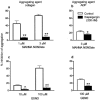Inhibition of rat platelet aggregation by the diazeniumdiolate nitric oxide donor MAHMA NONOate
- PMID: 12429580
- PMCID: PMC1573589
- DOI: 10.1038/sj.bjp.0704971
Inhibition of rat platelet aggregation by the diazeniumdiolate nitric oxide donor MAHMA NONOate
Abstract
1. Inhibition of rat platelet aggregation by the nitric oxide (NO) donor MAHMA NONOate (Z-1-N-methyl-N-[6-(N-methylammoniohexyl)amino]diazen-1-ium-1,2-diolate) was investigated. The aims were to compare its anti-aggregatory effect with vasorelaxation, to determine the effects of the soluble guanylate cyclase inhibitor, ODQ (1H-[1,2,4]oxadiazolo[4,3-a]quinoxalin-1-one), and to investigate the possible role of activation of sarco-endoplasmic reticulum calcium-ATPase (SERCA), independent of soluble guanylate cyclase, using thapsigargin. 2 MAHMA NONOate concentration-dependently inhibited sub-maximal aggregation responses to collagen (2-10 micro g ml(-1)) and adenosine diphosphate (ADP; 2 micro M) in platelet rich plasma. It was (i). more effective at inhibiting aggregation induced by collagen than by ADP, and (ii). less potent at inhibiting platelet aggregation than relaxing rat pulmonary artery. 3. ODQ (10 micro M) caused only a small shift (approximately half a log unit) in the concentration-response curve to MAHMA NONOate irrespective of the aggregating agent. 4. The NO-independent activator of soluble guanylate cyclase, YC-1 (3-(5'-hydroxymethyl-2'-furyl)-1-benzyl indazole; 1-100 micro M), did not inhibit aggregation. The cGMP analogue, 8-pCPT-cGMP (8-(4-chlorophenylthio)guanosine 3'5' cyclic monophosphate; 0.1-1 mM), caused minimal inhibition. 5. On collagen-aggregated platelets responses to MAHMA NONOate (ODQ 10 micro M present) were abolished by thapsigargin (200 nM). On ADP-aggregated platelets thapsigargin caused partial inhibition. 6. Results with S-nitrosoglutathione (GSNO) resembled those with MAHMA NONOate. Glyceryl trinitrate and sodium nitroprusside were poor inhibitors of aggregation. 7. Thus inhibition of rat platelet aggregation by MAHMA NONOate (like GSNO) is largely ODQ-resistant and, by implication, independent of soluble guanylate cyclase. A likely mechanism of inhibition is activation of SERCA.
Figures





Similar articles
-
Cyclic GMP-independent relaxation of rat pulmonary artery by spermine NONOate, a diazeniumdiolate nitric oxide donor.Br J Pharmacol. 2000 Oct;131(4):673-82. doi: 10.1038/sj.bjp.0703613. Br J Pharmacol. 2000. PMID: 11030715 Free PMC article.
-
Specific inhibitory effects of the NO donor MAHMA/NONOate on human platelets.Eur J Pharmacol. 2014 Jul 15;735:169-76. doi: 10.1016/j.ejphar.2014.04.027. Epub 2014 Apr 26. Eur J Pharmacol. 2014. PMID: 24780647
-
Evidence for a cyclic GMP-independent mechanism in the anti-platelet action of S-nitrosoglutathione.Br J Pharmacol. 1998 May;124(1):141-8. doi: 10.1038/sj.bjp.0701821. Br J Pharmacol. 1998. PMID: 9630353 Free PMC article.
-
[Soluble guanylate cyclase in the molecular mechanism underlying the therapeutic action of drugs].Biomed Khim. 2012 Jan-Feb;58(1):32-42. doi: 10.18097/pbmc20125801032. Biomed Khim. 2012. PMID: 22642150 Review. Russian.
-
Evidence for, and importance of, cGMP-independent mechanisms with NO and NO donors on blood vessels and platelets.Curr Vasc Pharmacol. 2005 Jan;3(1):41-53. doi: 10.2174/1570161052773933. Curr Vasc Pharmacol. 2005. PMID: 15638781 Review.
Cited by
-
In Vivo Characterization of a Red Light-Activated Vasodilation: A Photobiomodulation Study.Front Physiol. 2022 May 2;13:880158. doi: 10.3389/fphys.2022.880158. eCollection 2022. Front Physiol. 2022. PMID: 35586710 Free PMC article.
-
Recent Developments in Pharmacological Effect, Mechanism and Application Prospect of Diazeniumdiolates.Front Pharmacol. 2020 Jun 23;11:923. doi: 10.3389/fphar.2020.00923. eCollection 2020. Front Pharmacol. 2020. PMID: 32655397 Free PMC article. Review.
-
What is the potential use of platelet-rich-plasma (PRP) in cancer treatment? A mini review.Heliyon. 2020 Mar 28;6(3):e03660. doi: 10.1016/j.heliyon.2020.e03660. eCollection 2020 Mar. Heliyon. 2020. PMID: 32258495 Free PMC article. Review.
-
The anti-aggregating effect of BAY 41-2272, a stimulator of soluble guanylyl cyclase, requires the presence of nitric oxide.Br J Pharmacol. 2010 Nov;161(5):1044-58. doi: 10.1111/j.1476-5381.2010.00943.x. Br J Pharmacol. 2010. PMID: 20977455 Free PMC article.
-
Inhibitory effects of total saponin from Korean red ginseng via vasodilator-stimulated phosphoprotein-Ser(157) phosphorylation on thrombin-induced platelet aggregation.J Ginseng Res. 2013 Apr;37(2):176-86. doi: 10.5142/jgr.2013.37.176. J Ginseng Res. 2013. PMID: 23717170 Free PMC article.
References
-
- ABRAMS J. Beneficial actions of nitrates in cardiovascular disease. Am. J. Cardiol. 1996;77:31–37. - PubMed
-
- AISSA J., FEELISCH M.Generation of nitric oxide accounts for the anti-platelet effect of organic nitrates–the role of plasma components and vascular cells The biology of nitric oxide. I. Physiological and clinical aspects 1992Colchester: Portland Press; 142–144.ed. Moncada, S., Marletta, M.A., Hibbs, J.B., & Higgs, E.A. pp
-
- AMANO M., TAKAHASHI M., KOSAKA T., KINOSHITA M. Differential inhibition of platelet aggregation and calcium mobilization by nitroglycerin and stabilized nitric oxide. J. Cardiovasc. Pharmacol. 1994;24:860–866. - PubMed
Publication types
MeSH terms
Substances
LinkOut - more resources
Full Text Sources

